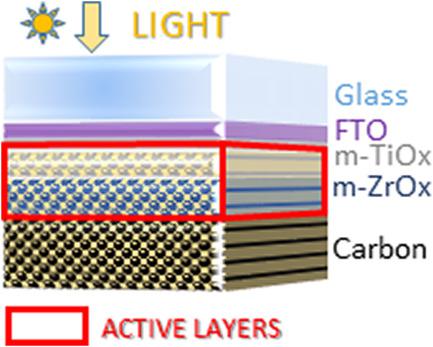Our official English website, www.x-mol.net, welcomes your
feedback! (Note: you will need to create a separate account there.)
On the Electro‐Optics of Carbon Stack Perovskite Solar Cells
Solar RRL ( IF 6.0 ) Pub Date : 2019-07-26 , DOI: 10.1002/solr.201900221 Robin Kerremans 1 , Oskar J. Sandberg 1 , Simone Meroni 2 , Trystan Watson 2 , Ardalan Armin 1 , Paul Meredith 1
Solar RRL ( IF 6.0 ) Pub Date : 2019-07-26 , DOI: 10.1002/solr.201900221 Robin Kerremans 1 , Oskar J. Sandberg 1 , Simone Meroni 2 , Trystan Watson 2 , Ardalan Armin 1 , Paul Meredith 1
Affiliation

|
Mesoporous carbon stack architecture is attracting considerable interest as a candidate for scalable, low‐cost perovskite solar cells amenable to high‐throughput manufacturing. These cells are characterized by microns‐thick mesoporous titania and zirconia layers capped by a nonselective carbon electrode with the whole stack being infused with a perovskite semiconductor. Although the architecture does not deliver the >20% power conversion efficiencies characteristic of perovskite planar and mesoporous geometries, it does produce cells with respectable efficiencies >16%, which is unexpected due to the carbon electrode being a nonideal anode and the active layers being so thick. Optimization of these cells requires an understanding of the coupled efficiencies of light absorption, charge generation, and extraction which is currently unavailable. Herein, a combined experimental‐simulation study that elucidates photogeneration and extraction is reported. By determining the optical constants of the individual components and using effective‐medium approximations, the internal quantum efficiencies (IQE) in both the titania and zirconia layers are determined to be ≈85%. Numerical drift‐diffusion simulations indicate that this high IQE is a consequence of the thick junctions reducing minority carrier concentrations at the electrodes, thereby decreasing surface recombination. This insight can now be used to tune the carbon stack for efficiency and simplicity.
中文翻译:

碳堆栈钙钛矿太阳能电池的光电学
作为适合于高通量制造的可扩展,低成本钙钛矿太阳能电池的候选者,中孔碳堆叠架构吸引了相当大的兴趣。这些电池的特征是微米厚的介孔二氧化钛和氧化锆层被非选择性碳电极覆盖,整个电池堆都注入了钙钛矿半导体。尽管该架构无法提供钙钛矿平面和中孔几何形状的> 20%的功率转换效率,但它确实会产生具有> 16%的可观效率的电池,这是出乎意料的,因为碳电极是非理想的阳极,而活性层是如此厚的。这些电池的优化需要了解光吸收,电荷产生和提取的耦合效率,而这是目前尚不可用的。本文报道了一项结合实验模拟的研究,阐明了光生和提取。通过确定各个成分的光学常数并使用有效介质近似值,可以确定二氧化钛和氧化锆层的内部量子效率(IQE)约为85%。数值漂移扩散模拟表明,这种高IQE是厚结减少了电极上少数载流子浓度的结果,从而降低了表面重组。现在,可以将这种见解用于调整碳堆的效率和简便性。二氧化钛和氧化锆层的内部量子效率(IQE)被确定为≈85%。数值漂移扩散模拟表明,这种高IQE是厚结减少了电极上少数载流子浓度的结果,从而降低了表面重组。现在,可以将这种见解用于调整碳堆的效率和简便性。二氧化钛和氧化锆层的内部量子效率(IQE)被确定为≈85%。数值漂移扩散模拟表明,这种高IQE是厚结减少了电极上少数载流子浓度的结果,从而降低了表面重组。现在,可以将这种见解用于调整碳堆的效率和简便性。
更新日期:2019-07-26
中文翻译:

碳堆栈钙钛矿太阳能电池的光电学
作为适合于高通量制造的可扩展,低成本钙钛矿太阳能电池的候选者,中孔碳堆叠架构吸引了相当大的兴趣。这些电池的特征是微米厚的介孔二氧化钛和氧化锆层被非选择性碳电极覆盖,整个电池堆都注入了钙钛矿半导体。尽管该架构无法提供钙钛矿平面和中孔几何形状的> 20%的功率转换效率,但它确实会产生具有> 16%的可观效率的电池,这是出乎意料的,因为碳电极是非理想的阳极,而活性层是如此厚的。这些电池的优化需要了解光吸收,电荷产生和提取的耦合效率,而这是目前尚不可用的。本文报道了一项结合实验模拟的研究,阐明了光生和提取。通过确定各个成分的光学常数并使用有效介质近似值,可以确定二氧化钛和氧化锆层的内部量子效率(IQE)约为85%。数值漂移扩散模拟表明,这种高IQE是厚结减少了电极上少数载流子浓度的结果,从而降低了表面重组。现在,可以将这种见解用于调整碳堆的效率和简便性。二氧化钛和氧化锆层的内部量子效率(IQE)被确定为≈85%。数值漂移扩散模拟表明,这种高IQE是厚结减少了电极上少数载流子浓度的结果,从而降低了表面重组。现在,可以将这种见解用于调整碳堆的效率和简便性。二氧化钛和氧化锆层的内部量子效率(IQE)被确定为≈85%。数值漂移扩散模拟表明,这种高IQE是厚结减少了电极上少数载流子浓度的结果,从而降低了表面重组。现在,可以将这种见解用于调整碳堆的效率和简便性。











































 京公网安备 11010802027423号
京公网安备 11010802027423号